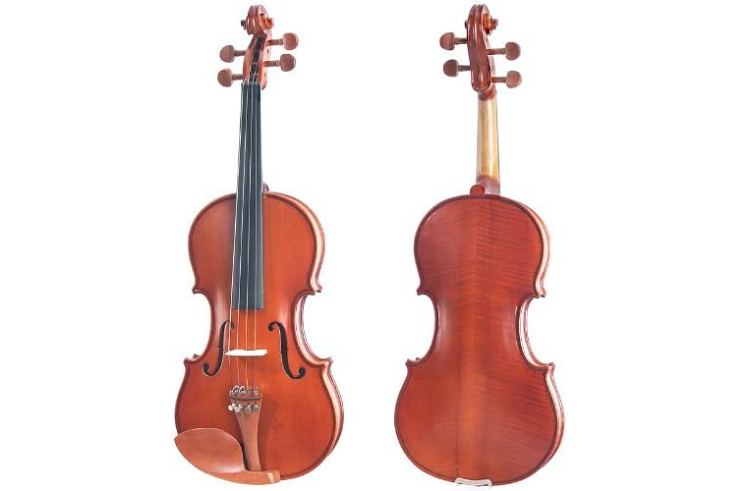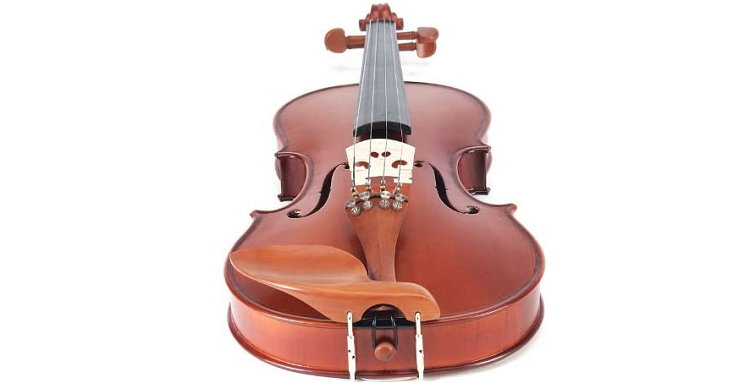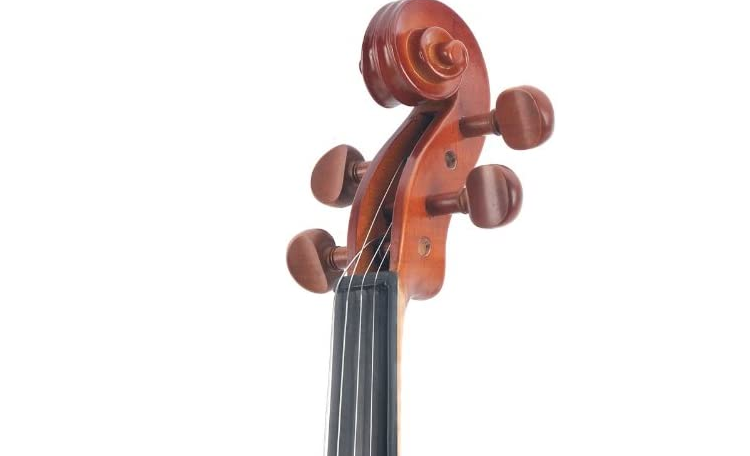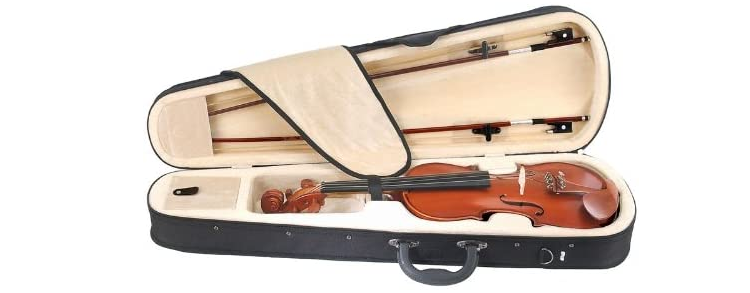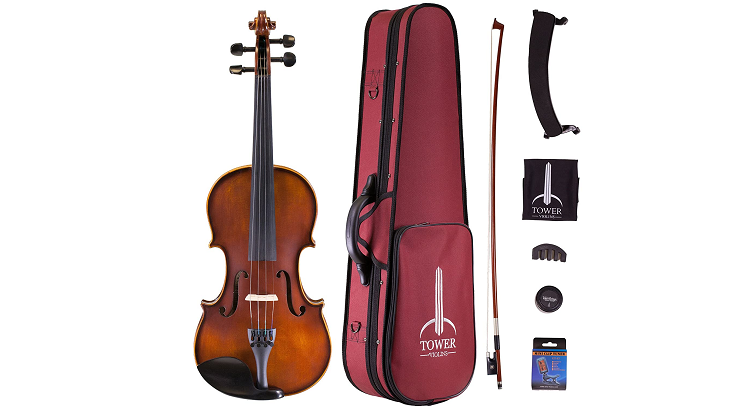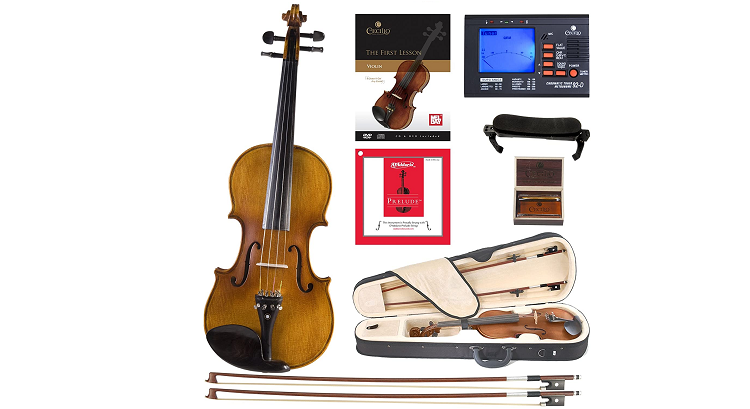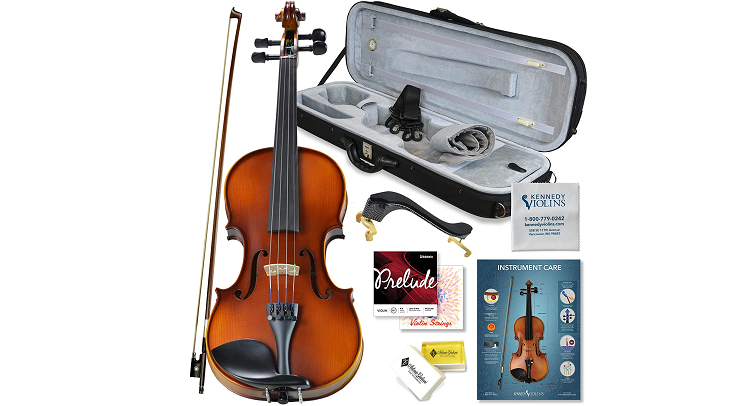- Best Fretted Violins Guide - May 31, 2022
- Best Yamaha Violins Brand Guide - April 13, 2022
- An Honest Mendini MV300 Review - March 31, 2022
For several years, Cecilio has been making inexpensive and occasionally poor-quality violins and other band and orchestra instruments. At one time, they featured over 14 different violin models between their Cecilio and Mendini lines.
They have started to narrow down what they offer to only the best-selling instruments in recent years. This has taken the Cecilio line from 8 easily accessible violins to 6 if you include their electric model, of course.
The first two on the chopping block are the CVN 400 and 700. Unfortunately, that means the subject of this review has been discontinued.
While I don’t find this a bad thing, for those searching for this violin specifically, don’t fret; finding it in the wild is possible. However, I encourage you to look at my alternative recommendations for a higher-quality violin from a more reputable dealer.
Pros, Cons, and Bottomline
Discontinuing the CVN 400 was a good move for Cecilio; I wouldn’t recommend this violin even if it was still on the market. In general, Cecilio isn’t my first recommendation for a violin or any instrument. Without a doubt, for roughly an extra 100 dollars, you can find a much nicer violin that will remain a working musical friend for longer.
Between the CVN 400s specs and company reputation, I wouldn’t recommend this violin at all, even if you did find one used. However, the CVN 500 is decent for the price and a considerable quality improvement. However, my top alternative pick is The Tower Strings Entertainer from Fiddlershop. So without further ado, let gets into the nitty-gritty.
Pros
- Inexpensive for a first-time player or for someone who is unsure about the violin but doesn’t want to or can’t rent a violin.
- Comes with everything you need to get started.
Cons
- Made from cheap materials compared to violins that are only a bit more expensive
- Cecilio isn’t known for product consistency or setting up their instruments properly.
- Extremely bright and tinny tone
- Some accessories will need to be replaced ASAP.
Buying A Violin Online
Buying a violin can be both frustrating and overwhelming. If you are looking for a Cecilio violin, chances are that you are looking for your first violin. Or, perhaps you have rented a violin and would like to buy your own.
In both cases, we will discuss what exactly makes a student violin, how to spot a good one from a bad one, along why Cecilio sometimes misses the mark.
Depending on your circumstances, what someone recommends for a student violin will vary, and it may or may not be helpful. For the purpose of this review, we’ll focus on buying a violin online over renting or going to a music store because Cecilio violins are typically sold online, mainly through Amazon.
When buying a violin online, it’s essential to look for a few basic things in the listing, carefully vet each listing, or purchase from a reputable online source like Fiddlershop, Kennedy Violins, Shar Music, or Johnson Strings.
Student Violin Materials and What to Watch Out for
Violins are made out of unique hardwoods called tonewoods; these tonewoods are chosen for their ability to resonate frequencies and produce a beautiful sound. Violins and other orchestra string instruments are made from spruce and maple. Tonewoods are sourced from particular trees, usually at high altitudes, with European being considered the best.
Student violins are all over the map in terms of tonewood quality. You can find beautiful violins made from aged and unaged woods and Chinese or European tonewoods.
With that said, how tonewoods are carved and the overall quality of the wood does matter. Hand-carved tonewoods mean that a person has personally carved out the violin’s body from a piece of wood. This can indicate a higher level of quality in other areas of the violin, such as wood choice and the quality of the materials that the rest of the violin is made out of.
However, hand-carved can be misleading as manufacturers will use electric hand tools instead of actual hand tools, whereas a master Luthier would use non-electric hand tools. Therefore, technically the instrument is still machine carved.
While tonewoods are perhaps the most critical aspect of a violin’s tone outside of the overall setup for online violins, the most significant indicator of a poor quality violin is the fingerboard material.
Typically orchestra string instruments have fingerboards made out of ebony wood. An extremely durable wood that is chosen to withstand the oil and bacteria from our fingertips.
Some cheaper violins will have fingerboards made from maple. This wood isn’t as durable as ebony or as common. Still, it can last for several years and is generally considered acceptable on student violins.
However, it’s not my preferred choice, and I always recommend something with an ebony fingerboard. If a violin is made from dyed hardwood or simply hardwood, then that violin isn’t going to be of good quality. Pay attention to the listing and the amount of information about the instrument you are purchasing.
The rest of the violin comprises the fittings and the overall setup. The fittings include the tailpiece, pegs, bridge, and strings. These can vary, but for most student instruments, you will find an ebony tailpiece with a fine tuner for each string. Fine tuners are a point of frustration for me, especially when it comes to Cecilio violins.
Their cheaper violins like the pegs will likely be ebony. Like the fingerboard dyed hardwood, it is a good tell if the violin is not of good quality. The bridge can vary; each seller likely has their own preference and maker; some may even make their own. The most important thing is that these pieces are correctly fitted to the violin.
The Setup
The setup is where Cecilio seems to struggle the most to produce high-quality products.
While the violin’s body may be decent and the fingerboard may be perfectly graduated; if the violin isn’t setup well, with a properly placed soundpost, correct string height, properly reamed pegs, and a well-placed endpin and a decent set of strings, then your violin won’t sound its best. It might not even feel or be playable.
A well setup violin is one of the most important aspects of getting started for students. It allows you to draw a good tone and feel more comfortable playing your instrument.
Many online violin retailers pride themselves on making sure every instrument they sell has been correctly set up by a luthier. While the instruments are typically made in China, just like Cecilio, they are first shipped to their primary location or workshop for the brand and set up there.
This small attention to detail puts violins from retailers like Kennedy Violins and Fiddlershop and step above the rest. It’s also what makes Cecilio a problematic brand to recommend to people.
The Outfit
Student violins come in outfits; in other words, you will receive everything you need to get started. An outfit can include a case, bow, and rosin, including everything and the kitchen sink.
Cecilio tends to lean on the side of everything and the kitchen sink. As a new player getting everything and the kitchen sink can be extremely helpful. But it doesn’t always mean that the products are high quality.
Out of all of the accessories you could receive, the bow and shoulder rest are potentially the most important in term of quality. I prefer carbon fiber bows for students over brazilwood bows for durability.
I also like Fiddlershop carbon fiber shoulder rests. Still, Kun and Everest also make some fantastic and highly sought-out shoulder rests. The rosin is very important, too, but I’ve used many different kinds and still have yet to find one that truly stood out against the rest.
The case will likely be a small triangle case with little storage. This is fine for the first few years as it’s likely when you upgrade your violin, you will also receive a new case, or at least that is the perfect time to purchase a new case.
The rest can include anything from extra strings to a tuner. Just remember more isn’t always better; your primary concern should be the instrument itself; accessories can be replaced.
Why I Don’t Recommend the CVN400
If the CVN400 was still available, I wouldn’t recommend it to anyone. It’s not a high-quality violin, and it’s clear why Cecilio decided to focus their efforts on the CVN300 and market it as their main violin. The body is made from your typical spruce and maple tonewoods, but there are no specifications to where the wood comes from or how it’s carved.
I’m assuming hand-carved via machine, meaning they use electric hand tools where a master luthier would use hand tools. This is a way for a company to say their instruments are hand-carved when they really aren’t. The purfling is most certainly done by a machine, but this is not that unusual.
The fingerboard and fittings are where it gets dicier for Cecilio. The fingerboard is the dreaded dyed hardwood; they specify rosewood in the fine text, which doesn’t thrill me. The pegs and fittings are made from boxwood. This is perfectly acceptable but unusual for a cheaper student instrument, but I like the variation.
The tailpiece has 4 detachable fine tuners, which are great because Cecilio’s fine tuners tend to be horrible and break easily. Detachable fine tuners can easily be swapped for higher-quality ones during a string change, and it’s a pretty inexpensive fix. So Cecilio gets their one point in that category.
The Setup
Cecilio fails by having their instruments set up in their workshop in China instead of having a skilled luthier complete this part. This, of course, saves money and allows them to offer their instruments at lower prices.
But it also means there is a high likelihood that you, the buyer, will need to take your violin in to be correctly set up by a luthier; at a minimum, it’s best to at least have it checked to make sure that everything is in the correct spot and at the correct height. This adds to the overall cost and leaves you better off purchasing a higher quality violin.
The bridge is of the most concern. Typically Cecilio will ship their instruments with the bridge down. This protects the instrument from potential damage should the bridge come loose during shipping. Still, it means that new players are tasked with placing the bridge themselves.
This isn’t the most challenging task, but you have to be careful that the bridge is placed at the correct spot and isn’t tilted or off-center. Cecilio may not properly carve the bridge either, and a luthier may want to adjust or even replace it altogether.
All sound resonates through the bridge; it’s essential that you use one that is of high quality and properly fitted to your violin.
Cecilio branded instruments use D’Addario Prelude strings, which is pretty standard among the student violin world. They will also include a set of poor-quality Cecilio branded strings that I recommend tossing.
They are horrible quality, sound terrible, and will break quite quickly; you are better off purchasing an extra set up Preludes as backups. Of course, if you find a CVN400 in the wild, then it will have had, or it will need a string change for sure.
The Outfit
As I mentioned earlier, Cecilio tends thot how everything and the kitchen sink into their outfits. This helps them sell violins because people feel like they are getting a great deal for the money. In reality, the accessories are of inferior quality and typically need to be replaced within the first six months.
The bows are the worst offender; they include two brazilwood bows. These bows tend to come poorly made. The first point of failure is usually the hair quality. Every violinist will occasionally break some hair while playing, but a new student shouldn’t constantly shed hair.
The second point is the stick; there’s about a 50/50 chance that you’ll get a well-balanced unwarped stick. I recommend upgrading to a carbon fiber bow from Cadenza, Fiddlershop, or Glasser. Fiddlershop has the cheapest and highest quality carbon fiber bows on the market currently.
The rest of the outfit includes the primary triangle case, which I’m not really a fan of. It’s just so small, but it’ll do for a beginner, as I mentioned. I found the Cecilio shoulder rest to be pretty terrible.
It’s small awkward, and cumbersome; it was the first thing I replaced. The rosin is essential; I used it for a while but eventually moved on to higher-quality rosin. I like D’Addario rosin, and I like Magic Rosin as well, but there are so many types out there, check out our buying guide here!
This violin didn’t come with a tuner and other extras, unlike current Cecilio outfits. This is fine because it’s highly unlikely you would receive those items if you found a used CVN400.
What She Sounds Like
This really is the big question when it comes to violins. What is the overall tone of the instrument? Students can expect a relatively empty but overall even tone from their violin. I find student violins to be nasaly and bright, but overall they are decent instruments.
As you progress and perhaps join an orchestra or ensemble, you will want to find a violin that fits well into that setting and has some personality that you enjoy. I personally like violins that are warmer and have a vibrant tone.
The CVN400 fits the description of a basic student violin tone; it’s very tinny. I dislike this violin’s tone and would have no problem going for the CVN500 over this due to its darker tone.
The lower register is pretty clear, but of course, it’s also very bright. The upper register is very shrill. It sounds the tiniest, overall just unpleasant to listen to every day right next to your ear.
Higher-quality violins will warm up over time. Even if they are brand new after a while, they’ll sound more complex and take on a personality of their own. The CVN400 isn’t capable of that.
The tonewoods aren’t of a high enough quality, and the woods won’t last long enough to age. In some cases, these instruments use thinner tonewoods that sound better short-term and degrade over time, which is the opposite of a better violin. I can see Cecilio doing precisely that.
You can, however, improve the tone by switching out the student quality strings to something more robust and deep! Obligatos are one the more well-known brands for mellowing out a bright violin.
However, Obligatos are very expensive for new students. I would recommend moving to Dominants, Fiddlershop Strings, or D’Addario Pro Arte’s for a more affordable string set that will still help the violin produce a warmer tone.
Where to Find the CVN400
If, for some reason, you are still convinced that the CVN400 is for you and are prepared for a scavenger hunt that may or may not lead to gold, then you will be wondering where you can find this violin.
I would first check your local pawn shops and local stores for used violins they may have. Next, I would check various online platforms, eBay, Reverb, and Facebook Marketplace.
I have yet to find a used CVN400, but I have found quite a few MV400s, the sister violin from the Mendini line. In general, I’m assuming that these violins aren’t worth trying to sell used online. But, you are more likely to find them in physical locations.
Alternatives to the CVN400
Top Pick: Tower Strings Entertainer by Fiddlershop
The Tower Strings Entertainer is a versatile student-quality violin from my favorite violin shop, Fiddlershop! This violin is about 100 dollars more than what the CVN400 would cost currently on Amazon, and it’s worth every bit of that money. This violin is made from dried spruce and maple tonewoods, with an ebony fingerboard and fittings.
The tailpiece includes 4 built-in fine tuners that I can personally vouch for the quality. My frustration with fine tuners runs deep, so I’d never recommend built-in fine tuners that I know would break. The bridge is hand-carved, and of course, this violin is hand setup by a Luthier in their workshop in the USA.
The outfit includes a high-quality brazilwood bow, small, lightweight triangle case, Tower String’s rosin, shoulder, practice mute, polishing cloth, and a digital tuner.
I currently still use their brazilwood bow as a backup; there is nothing special about it but its well balanced and made from quality materials. It will serve a student well for their first year or two.
I also regularly use the shoulder rest and like it; it’s highly adjustable and comfortable. The case is small, and I’m looking for an upgrade currently, but it works well until you want to upgrade.
Cecilio Alternative: CVN500
The CVN500 is a violin currently available from Cecilio, and it’s not too bad for the price. It hits the essential quality marks but will still suffer from the same potential problems as the CVN400. While it’s not my first choice, I keep reserved for people who really need a budget violin.
Its made from the basic solid spruce and maple wood with light flaming on the back. It has an ebony fingerboard and fittings and 4 detachable fine tuners. It comes setup with D’Addario Prelude Strings. Of course, you will want to make sure that a professional luthier has correctly set it up.
As usual, it comes with everything, including 2 poor-quality bows, a shoulder rest, rosin, lesson book, and tuner. The accessories will need to be swapped out for better ones rather quickly. But the rosin and tuner will remain useful for a while.
Amazon Pick: Bunnel Pupil Violin by Kennedy Violins
There is no denying that Amazon is incredibly convenient. Luckily, there are some excellent quality violins available on the website. Kennedy Violins is a local violin store based out of Washington and considered a go-to. They sell their student violins online, and the Bunnel Pupil is one of their most highly rated.
Like Fiddlershop, they set up each of their violins in their workshop in the USA. They custom fit the bridge and use D’Addario Prelude Strings, so you know you will get the best sound. They understand that an improper setup can damage the instrument and hinder students’ progress. I trust they use high-quality fittings and fine tuners.
The violin is made from solid maple and spruce tonewoods, an ebony fingerboard and fittings, and a similar tailpiece to Fiddlershop. The outfit includes a large case with plenty of storage and a pocket perfect for your shoulder rest!
The included bow is basic brazilwood, but it’s high quality and well balanced. A decent quality shoulder rest that looks very similar to my Fiddlershop shoulder rest and, of course, rosin, extra strings, polishing cloth, and a guidebook.
FAQs
Answer: Cecilio violins are made in China and then sold by Amazon. Typically they are dropped, shipped to a warehouse, and shipped out as ordered. The wood used to make the violin is mostly likely sourced in China.
Answer: Purfling is the line that runs along the edge of the violin. This protects the violin from cracking when the wood shrinks and expands during temperature and humidity changes. Cheaper violins may not have purfling, but we call these VSOs or violin-shaped objects.
Answer: I recommend everyone starts with a teacher because it will keep you from developing bad habits along the way, and you will likely learn a lot quicker. However, I’m self-taught for the most part. Overall, my teacher wasn’t horrified at my technique, so I know it is possible to learn on your own with diligence and self-reflection.
Final Thoughts on the CVN400
Cecilio has made many choices during its time as a company; slimming its line down to include only the best-sellers was a good move. The CVN400 is definitely one of their lower quality violins, and discontinuing it allowed them to refocus on their better selling violins like the CVN300 and 500.
I consider the CVN500 the best violin under 200 with tax, honestly. However, I would still consider a Fiddlershop or Kennedy violin over any Cecilio model any day.
Looking for more interesting readings? Check out:


